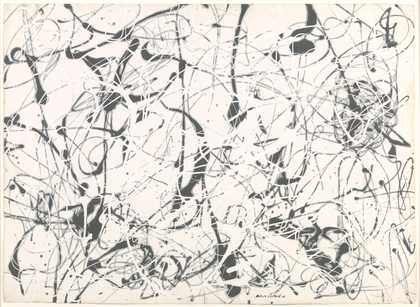I first became aware of Jackson Pollock’s work when I was 17. I spent most of my free time in New York at the Museum of Modern Art, where the Pollocks were often on display.
He used a very liquid paint that he could make fly through the air and fall on to the canvas, showing his emotions and gestures without the brush necessarily touching the surface. The black pourings were a completely new kind of physical idea, the paint and surface of the canvas almost playing out a dialogue of simultaneous energy and restraint. These works seem really to sit between two very interesting narratives: on the one hand they almost look like graphic design, and on the other they have everything in a very synthesised way that the more famous drip paintings had.
Pollock would use turpentine as a thinner added to the enamel paint, so he could pour and throw it on to the canvas. As well as sticks and brushes, he also used a turkey baster to squirt, drop and fling the mixture towards the surface, creating great sweeps and bursts of paint.
It’s unfortunate we didn’t get to see what he might have gone on to do if he had not died young. His black pourings represented an exciting new phase filled with so much potential. It’s fascinating that the critic Clement Greenberg and others labelled them as a regression – that he had betrayed his audience by regressing to the figure (such as the work opposite). I believe there were very important reasons for this exploration, and it’s still a mystery that many artists are trying to solve. However, a lot of others have picked up from where he left off, including me. I am compelled by what he did, especially the black pourings.

Jackson Pollock
Number 23 (1948)
Tate
In my case, I might use paint that is really thick and almost like clay, so it’s very hard to get on the canvas and I’m forced to paint in a very physical way. I have to work myself up into this high-energy state. I tend to paint very fast, and that produces a certain result: the amount of energy that needs to be built into the process of painting is determined by the way I set up the material conditions – similar to Pollock’s method.
